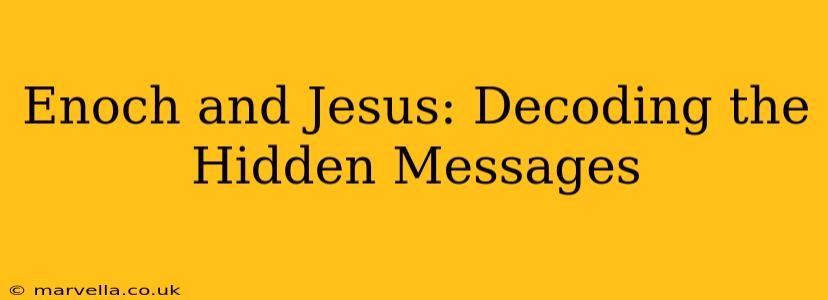The enigmatic figures of Enoch and Jesus, separated by millennia, share intriguing parallels that have captivated theologians and scholars for centuries. While seemingly disparate in their historical contexts, a deeper examination reveals striking similarities in their narratives, prophecies, and ultimate destinies, hinting at a hidden connection that continues to fascinate and inspire debate. This exploration delves into the shared themes and hidden messages woven into the stories of these two pivotal figures.
Who Was Enoch?
Enoch, mentioned in the Book of Genesis and the Book of Enoch (an apocryphal text), is described as a righteous man who "walked with God" and was taken directly to heaven without experiencing death. This "translation" or "rapturing" is a unique event in biblical narrative, setting him apart from other patriarchs. The Book of Enoch expands upon his life, portraying him as a prophet who received divine visions, detailing the fall of angels, the impending judgment, and the coming of a messianic figure. His righteous life and direct ascension to heaven establish him as a powerful symbol of faith and divine favor.
Who Was Jesus?
Jesus, the central figure of Christianity, is portrayed as the Son of God, born of a virgin, who lived a life of miracles, teachings, and ultimately, sacrificial death and resurrection. His ministry centered around preaching the Kingdom of God, performing miracles, and gathering followers. His resurrection is considered the cornerstone of Christian faith, offering believers the promise of eternal life and redemption.
The Parallels Between Enoch and Jesus: Hidden Messages
Several compelling parallels exist between the narratives of Enoch and Jesus:
1. Righteousness and Divine Favor:
Both Enoch and Jesus are depicted as exceptionally righteous individuals who enjoyed a close relationship with God. Enoch's righteousness is explicitly stated in Genesis, while Jesus's life embodies divine virtue and unwavering obedience to God's will. This shared characteristic underscores the importance of righteous living in achieving divine favor and fulfilling God's purpose.
2. Prophetic Visions and Revelation:
Enoch received divine visions outlining future events, including the judgment of the wicked and the coming of a messiah. While Jesus didn't explicitly receive visions in the same manner as Enoch, his teachings and parables contain prophetic elements, foretelling his own suffering, the destruction of the temple, and the establishment of a new covenant. Both figures functioned as conduits of divine revelation, communicating God's will to humanity.
3. Ascension and Glorification:
The most striking parallel lies in their respective ascensions. Enoch was taken directly to heaven without experiencing death, a foreshadowing of Jesus's ascension after his resurrection. This shared element emphasizes the theme of divine glorification and the ultimate triumph over death and earthly limitations. The "translation" of Enoch serves as a prefiguration of the resurrection and ascension of Jesus, highlighting the continuity of God's plan of salvation throughout history.
4. Prefigurations of the Messiah:
The Book of Enoch contains descriptions of a messianic figure who will bring judgment and establish a reign of righteousness. Some scholars argue that Enoch's role as a prophet and his heavenly ascension prefigure the coming of Jesus, the ultimate messianic figure in Christian theology. The descriptions of the messianic figure in Enoch are interpreted by some as reflecting certain aspects of Jesus's ministry and destiny.
Are There Hidden Messages? Interpretations Vary
The interpretations of the parallels between Enoch and Jesus are varied. Some see them as simple coincidences, others as deliberate foreshadowing, and still others as evidence of a deeper, more mystical connection. The differing viewpoints often depend on theological perspectives and interpretations of the relevant scriptures.
Frequently Asked Questions (FAQs)
Is the Book of Enoch considered canonical in the Bible?
No, the Book of Enoch is not considered part of the biblical canon by most Christian denominations. It's considered an apocryphal text, meaning it's not included in the officially accepted collection of sacred scriptures.
What is the significance of Enoch's translation?
Enoch's translation, his being taken directly to heaven without death, is a significant event signifying divine favor and a promise of future glory. It's seen by some as a prefiguration of Jesus's resurrection and ascension.
How do different religious traditions view the relationship between Enoch and Jesus?
Different religious traditions interpret the relationship between Enoch and Jesus in diverse ways. Some see it as a clear prophetic connection, while others emphasize the distinct historical contexts and theological differences between the two figures.
Does the Book of Enoch offer predictions about the future?
Yes, the Book of Enoch contains detailed descriptions of future events, including judgments, apocalyptic scenarios, and the coming of a messianic figure. These prophecies have been interpreted differently across various traditions.
In conclusion, the exploration of the parallels between Enoch and Jesus offers a fascinating glimpse into the rich tapestry of biblical narrative. Whether viewed as coincidences or intentional foreshadowing, the similarities between these two iconic figures invite deeper reflection on themes of righteousness, divine favor, prophecy, and the ultimate triumph of good over evil. The hidden messages remain open to interpretation, stimulating continued dialogue and scholarly inquiry.

